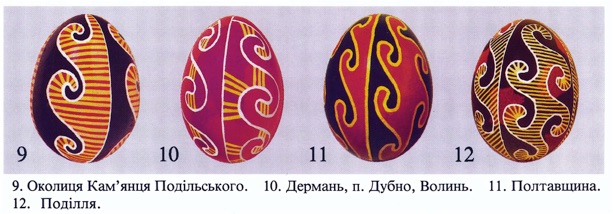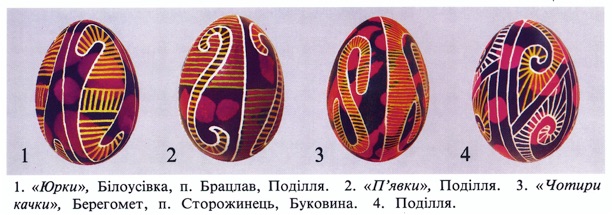Reptile Motifs

Slithery Pysanky
With the exception of snake/zmiya motifs, reptiles are not often seen on pysanky. The snake seen on pysanky is usually a serpent (zmiya), a representation of the ancient pre-christian god of earthly waters. It is a protective motif, and is represented by a spiral or sigma (S) shape.

Wavy lines (waves) are also representations of thе zmiya; they are called, variously, “snaking bezkonechnyk (безкінечник вужовий), wavy line (вилюшечка), crooked line (кривулька), paths (плаїки), and saw (пилка). The pysanky and motifs below are all from Selivachov, and all come from Vinnytsia:.

These motifs are called hadiuchky (vipers) or vuzhi (snakes), and, because they are manifestations of the zmiya, are protective symbols. These two pysanky are from Poltava, and are versions of the wave in example № 9.


Elyjiw gives more examples of the wave here from several different regions of Ukraine (Kamianets Podilskyi, Volyn, Poltava region, Podillia) in Table 32:

Much more common are snake motifs of the “S” type, as in Selivacho’s №10. These have often been renamed, as their ancient meanings have been forgotten. They are often called a “Yurok” (a staff with a hook at the end) or a “Piavka” (Leech) because of their shape. Here are several examples from Elyjiw:

Snakes appear in Ukrainian folklore. Selivachov notes that ethnographic records speak of snakes which attached themselves to women’s breasts as punishment for transgressing work taboos on holy days, but that, on the other hand, symbolic representations of snakes, vipers and frogs were used to protect newborn children.
Rybakov notes that according to archeologists, motifs of lizards and snakes first appeared in the Mesolithic era, in the post-Ice Age period. There are clay tablets from the early Bronze Age which depict Trypillian dwellings which contain the traditional ball of snakes (actually vipers, protecters of the home). These tablets suggest a different meaning for snakes at women’s breasts--the summoning of rain.
There are a few odd pysanky, though, which do depict reptiles. The first is this strange Hutsul one from Elyjiw--there is a row of turtles and what appear to be snakes with feet around the perimeter:

There are also a number of pysanky in Vira Manko’s book called “tortoise,” although none are as anatomically correct as the ones in the pysanka above. Some do look a bit like the creatures, others only vaguely so, and seem to be renamed svarha/cross combinations.







Tortoises, while interesting, do not have any strong symbolic meaning. In these pysanky, it is in the underlying symbols--crosses, svarhas, curls--where meaning lies.






